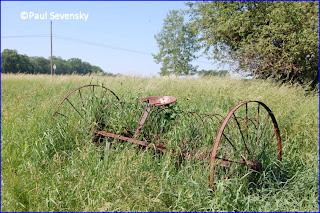I was adding to my photo collection a few weeks ago when I came across the Hickory Grove Cemetery, one of the oldest in my home territory of Lackawanna County, PA. I decided to take a stroll and soon became fascinated with the history unfolding before me. One particular grave caught my attention: Deacon John Phillips, "a soldier of the Revolution," the stone proclaimed. I hadn't expected to find a Revolutionary War veteran; I was thinking (mistakenly) that our area wasn't very well settled by the time most of those soldiers had passed on. Before leaving, I found the grave of another Revolutionary veteran, and thus began a history tour in stone.
Deacon John Phillips was not born in our area, but came here during the Revolution. I found a book written in 1994 by an eighth-generation descendent, Jacqueline Lois Miller Bachar, in which she compiled a collection of letters written to John by his sister, Mary Lott, dating from 1826 to 1846. At the time, Mary was living "on the frontier" – which in the 1820s was Delaware County, Ohio, something that should amuse my friend G's Cottage. John was one of the first landowners in Pittston in our neighboring Luzerne County, where he also was justice of the peace. He became a deacon of the First Baptist Church in Abington (a church I pass almost daily in the summertime enroute to Lackawanna State Park). Both Mary and John died in 1846; John was 94 years old.
Harboring the perception that most people in the Revolutionary era were short-lived (and indeed many were), I was stunned to see that Deacon Phillips had reached such an old age. So as I continued my photo travels over the next few weeks, I added another item to my itinerary: cemeteries. I was using a street atlas of a six-county area that conveniently happened to mark cemeteries both large and small, so as I searched for scenic vistas, barns, old advertising signs and the like, I would stop by any cemetery along the route. (No GPS for me; I blew the budget on the camera and lenses. Besides, it was more adventurous this way.)
My best results were in small rural cemeteries, often unnamed and limited to members of an extended family. Although I did find many people who had died relatively young – typhus, scarlet fever, diphtheria and other illnesses claimed many, I found a great deal of septuagenarians, octogenarians, nonagenarians and an occasional centenarian. Perhaps it was a stronger constitution fortified by a great deal of hard work just to live from day to day. I found a number of surnames that now grace townships, boroughs or roads; unusual first names, including Urania, Electa, Permelia, Ashketh, Orton, Pardon, Erastus and others; and an overwhelming variety of stone shapes, heights and thicknesses, some absolutely plain, others elaborately engraved with decorative art and flowing script.
I learned to recognize certain types of monuments: any stone with a lamb carved at the top (or a pair of shoes) invariably marked the resting place of a child. Maybe I started getting too familiar with monuments – as I approached one from the rear, I said to myself, "That looks like an 1870s style." Coming around to the front, I looked at the person's date of death: 1875. Now that's a little scary. As for inscriptions, many quoted Bible verses or other religious sentiments, but one was very succinct: "A Good Woman." I suppose the most poignant of the inscriptions I encountered was one on a very plain stone: "Sacred to the memory of Miss Priscilla Basset, who was drowned Feb. 18th A.D. 1806 in the 20th year of her age." I could see the image of a young woman in those words.
Each cemetery was a lesson in military history: in addition to Revolutionary War vets, I found graves of soldiers who fought in the War of 1812, the Mexican War 1846-1848, the Civil War, Spanish-American War, World Wars I and II, even Korea and Vietnam, although many of the rural cemeteries I visited stopped being active 50 years or more ago. Some had died in battle, with the heroism appropriately noted, while others survived the conflict (as did Deacon John Phillips) and lived to old age. One Union soldier had died in the notorious Andersonville Prison Camp of the Confederacy. The conclusion I came to: we've fought way too many wars.
Probably the most interesting was the family dynamics played out before me. Men from the 1800s were accompanied in rest by two, three or occasionally more wives, most likely having lost wives in childbirth and to disease. The last wife usually survived the husband, but not by long. One notable exception: a couple where the husband died in 1919 at age 56; his wife, buried with him, lived to be 104, dying in 1978. Their children buried alongside of them sometimes died in infancy or in the first decade of life. But more were begotten, in keeping with the social and physical needs of families living in rural areas in that era. If the children reached maturity, the next generation (and often the one after that) rested nearby.
Maybe this is the real stuff of history: plain, everyday folks living their lives, raising their children, struggling with livelihoods, fighting in wars and finally coming to rest. It may not be the history of great social movements, industry, commerce or technology; but it's the history of us all.












